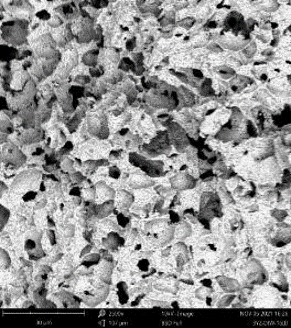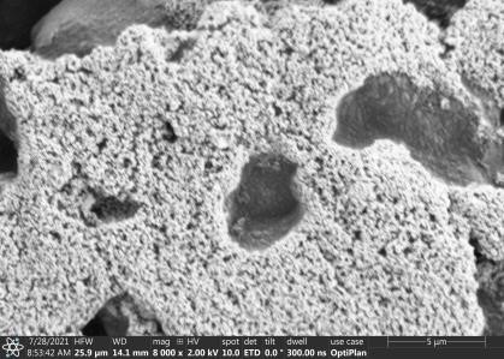Controlling the structure across multiple length scales is key to developing materials with multiple applications. Additive Manufacturing (AM) techniques, also known as 3D printing, have revolutionized the production of countless structures at different scales using all types of materials and have enabled the creation of lighter, stronger parts and systems that would otherwise have been impossible to create with conventional techniques. Direct-Ink-Write (DIW) is an AM technique that extrudes a shear thinning material through a nozzle to form a structure layer by layer on a translation stage. The use of ink as a feedstock is advantageous because it allows versatile compositions and complex geometries to be printed quickly. However, tuning the ink’s rheological behavior to enhance flow through the nozzle while maintaining its shape retention properties is sometimes a challenge. Several ceramic inks have been previously developed to for use in DIW printing.
The inventors have developed a 3% Yttria partially-stabilized Zirconia (3YZ) ceramic ink that produces parts with both nano and microporosity and is compatible with two AM techniques: DIW and projection microstereolithography (PμSL). The 3YZ nano-porous ceramic printed parts had engineered macro cavities measuring several millimeters in length, wall thicknesses ranging from 200 to 540 μm, and ~100 nm homogenous porosity within the wall structure. The microporosity is achieved by adding selected sizes of sacrificial particles that can then be 3D printed to introduce macro-porosity as desired. The ink rheology can be optimized for DIW and PμSL 3D printing processes. The combined open nanoporous and closed microporous 3D printed membranes surpass the limitations of conventional polymeric and hydroxide/ceramic dual-phase (HDCP) CO2 separation membranes employing a molten hydroxide liquid phase and nanoporous yttria-stabilized zirconia ceramic support phase.
Publication:
Troksa, A., Eshelman, H.V., Chandrasekaran, S., Rodriguez, N., Ruelas, S., Duoss, E.B., Kelly, J.P., Cerón, M.R., & Campbell, P.G. (2021). 3D-printed nanoporous ceramics: Tunable feedstock for direct ink write and projection microstereolithography. Materials & Design, 198, 109337. (https://doi.org/10.1016/j.matdes.2020.109337)
LLNL’s Porous Ceramic Filtration Membranes with Tunable and Multi-Scale Porosity technology has numerous advantages over traditional porous ceramic filtration membranes, such as:
- Allows broader range of particulate sizes that can be filtered
- Tailorable micro/nano-scale pore size structure for performance optimization
- Compatible with Direct-Ink-Write and Projection Microstereolithography (PμSL) 3D print processes
LLNL’s Porous Ceramic Filtration Membranes with Tunable and Multi-Scale Porosity technology has numerous applications including:
- CO2 Capture, Utilization and Storage (with a molten salt phase)
- Fuel Cells.
- High Efficiency Particulate Air (HEPA) filtration.
- Catalyst Support.
- Lightweight, High-Strength Building Materials.
- Substrates for Cell Growth.
Current stage of technology development: TRL 2 (October 2022)
LLNL has filed for patent protection on this invention.



